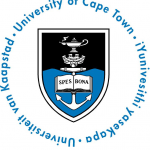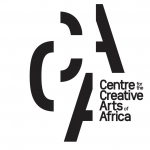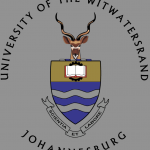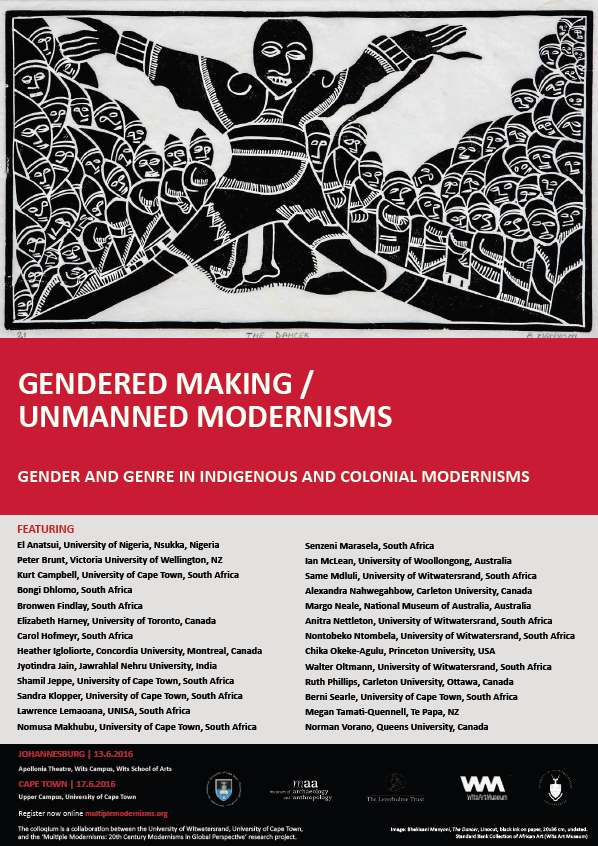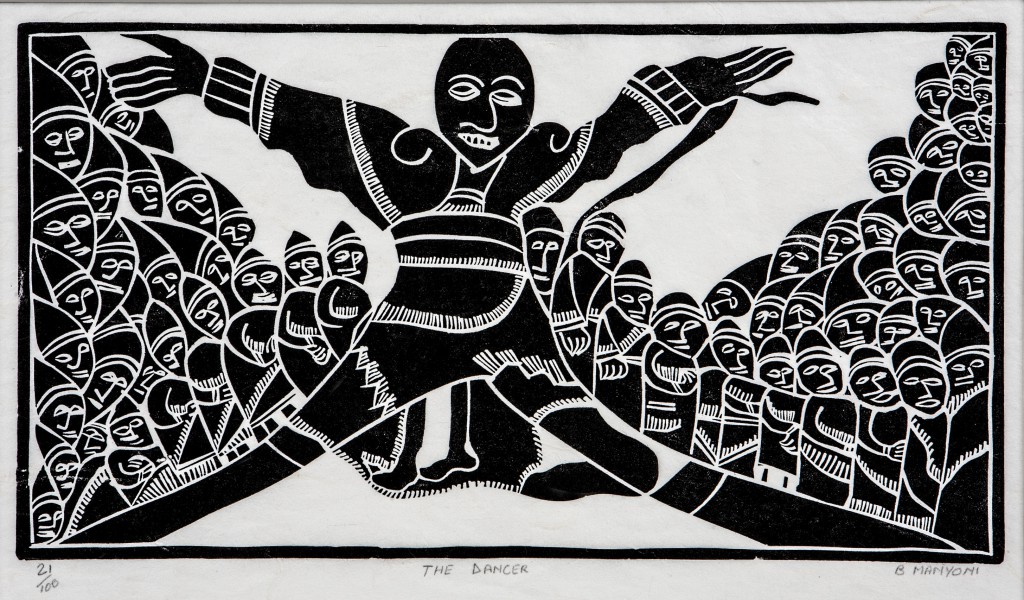
Image: Bhekisani Manyoni, The Dancer, Linocut, black ink on paper, 20×36 cm, undated. Standard Bank Collection of African Art (Wits Art Museum)
Gendered Making / Unmanned Modernisms: Gender and genre in indigenous and colonial modernisms was a symposium held in Capetown and Johannesburg, South Africa, June 2016.
Gender and genre are intersecting modes of categorization and evaluation that have received relatively little attention in the literature on multiple modernisms. Yet both are particularly sensitive barometers that manifest the degree to which Western art history has addressed – or failed to address – the modernist arts of colonized peoples in Africa, the Americas, the Pacific and elsewhere during the twentieth century. While there is an existing body of work on the relationships between gender, art/craft and modernity, this conference aims to open up more widely an interrogation of the ways in which hierarchies of art and craft and gendered making – particularly by women – have been represented, marginalized or elided in histories of the modernisms produced by peoples across the globe.
The colloquium is a collaboration between the University of Witwatersrand, University of Cape Town, and the ‘Multiple Modernisms: 20th Century Modernisms in Global Perspective’ research project. The symposium is convened by Anitra Nettleton and Sandra Klopper.
Modernist Tensions: Craft, Gender, Art
Wits School of Arts/ Wits Art Museum, Johannesburg
13th June 2016
09.00 Coffee and registration
SESSION 1
09.15 Welcome to Wits – Head of WSOA
09.30 Introduction to the Multiple Modernisms project – Ruth Phillips
10.00 Keynote speech Jyotindra Jain
10.30 Respondent – Anitra Nettleton
TEA 10.45- 11:15
SESSION 2
11:15 paper – Megan Tamati-Quennell
11:45 paper – Alexandra Nahwegahbow
12:15 Panel discussion, chaired by Walter Oltmann: Lawrence Lemaoana, Senzeni Marasela
LUNCH 13.15 – 14:00 at WAM Café
SESSION 3
14.00 paper – Margo Neale
14:30 paper – Kurt Campbell
15.00 Panel discussion, chaired by Ian McLean: Bongi Dhlomo, Bronwen Findlay, Same Mdluli
TEA 16.00- 16.30
SESSION 4
16.30 paper – Nomusa Makhubu
17.00 paper – Sandra Klopper
17.30 Discussion and questions – Elizabeth Harney
17.50 Closing remarks – Chika Okeke-Agulu
CLOSE 18:00
Modernist Tensions: Craft, Gender , Art
University of Cape Town, Cape Town
Friday, 17th June 2016
10h00 to 11h00 Opening Conversation: Chika Okeke Agulu and El Anatsui
Venue:
New Lecture Theatre, Upper Campus, University of Cape Town
11h15 Centre for African Studies (CAS) Exhibition : 1976 Remembered
On 16 June this year it will have been 40 years since the Soweto uprising, one of the most significant moments in the struggle against apartheid. To commemorate this event, the Centre for African Studies (CAS) is curating an exhibition of iconic imagery. See more at: http://www.africanstudies.uct.ac.za/
Venue:
Harry Oppenheimer Institute Building Level 3 Engineering Mall Road University of Cape Town.
12h00 Welcome from Shamil Jeppe, Director of HUMA
Venue:
Huma Seminar Room, 4th Floor, The Neville Alexander Building, University Avenue South, (Block: C2. Upper Campus, University of Cape Town
12h15 – 12h45 Intro to project: Elizabeth Harney
BREAK FOR LUNCH
13h45 Panel 1: Multiple Modernisms in comparative perspective
Peter Brunt
Norman Vorano
Heather Igloliorte
15h15 Panel 2: Modernism, craft, gender
Moderator: Sandra Klopper
Carol Hofmeyr: The Keiskamma Project
Nontobeko Ntombela: White Exhibitions, Black Artists: Attitudes to the Timeless Tribal
Anitra Nettleton: Beadwork, Craft and Language.
16h45 Closing remarks: Ruth Phillips
17h00 Finish
JYOTINDRA JAIN (Keynote address)
Gender and Genre: Conserving/Subverting the Mechanisms of Exclusion
The keynote will trace some of the trajectories of the marginalisation of the genre of indigenous modernity/contemporaneity within the grand narrative of art history and concerning the custody of art spaces in colonial and post-independent India. For decades now, in the Western art historical discourse and consequently in post-colonial South Asia and elsewhere, anonymity has been considered an essential characteristic of the artistic ethos of non-Western societies, which are deemed to be bereft of individuality and innovation, dwelling in an amorphous passive collectivity and timeless tradition. As pointed out by James Clifford, “authenticity in culture and art” of the indigenous people “exists just prior to the present”[1] – notwithstanding the conscious and enormous reflection of the contemporary aesthetic, social and political predicament addressed in the art of indigenous societies. In this scheme of things there occurs a double marginalisation of South Asian indigenous women artists – the general marginalisation of the genre of the indigenous itself coupled with the severe and rigid patriarchy within which they work has led to a heightened invisibility of this section of indigenous identity, whose access is further limited by the metropolitan art establishment’s furious guarding of art spaces and art discourses.
The keynote will centre on case studies of three brilliant indigenous women artists: the Mithila painter Ganga Devi, the Chhattisgarh clay relief artist Sonabai, and the Manipuri potter Neelamani Devi. All three rebelled against their inherited social predicament and successfully entered the space of the contemporary – or rather, a “space of another temporality”[2] – and in the process will critique the mechanisms of exclusion, both in terms of genre and gender. Such voices from diverse indigenous societies have not only opened up new spaces for self-expression but have provoked a reexamination of the discourse on modernity and contemporaneity itself.
Jyotindra Jain, formerly Director of the National Crafts Museum; Professor at the School of Arts & Aesthetics, Jawaharlal Nehru University; and Member Secretary of the Indira Gandhi National Centre for the Arts, all New Delhi, was a Visiting Professor at Harvard University and a Rudolf-Arnheim Professor at Humboldt University, Berlin. An eminent scholar and curator, his major publications include: Ganga Devi: Tradition and Expression in Mithila Painting; Other Masters: Five Contemporary Folk and Tribal Artists of India; Picture Showmen: Insights into the Narrative Tradition in Indian Art; Kalighat Painting: Images from a Changing World; Indian Popular Culture: ‘The Conquest of the World as Picture’; Francesco Clemente: Made in India.
His work on contemporary Indian folk and tribal arts is considered path-breaking and pioneering. He was recipient of the 1998 Prince Claus Award for Culture. Presently he is a Member of the International Advisory of the Humboldt-Forum, a major cult-arts project in Berlin, and Co-Editor of Marg Publications, Mumbai.
KURT CAMPBELL (Session 3)
The shape of things to come: the art object as epistemic agent in the exhibition Fever Sleep by Kurt Campbell
Various traditional frames conventionally deployed to produce African headrests/ wooden pillows were absent from the headrests featured in the exhibition Fever Sleep (2007). This was however not an oversight by the artist, but a carefully engineered insurrection that sought a fracturing of the disciplinary injunctions of ‘genre’, ‘authenticity’, ‘art’ and ‘craft’. The creations that comprised the Fever Sleep exhibition were therefore not produced as historical artifacts, but rather as bespoke objects that placated the desire of the artist for an ontological re-inscription in the ‘here’ and ‘now’ space of the post-apartheid.
The argument in this presentation is that artistic engagements with the past negotiating a conceptual route via objects of material heritage will increase. This is largely a result of national museum collections becoming more accessible to a wider audience. This fact necessitates a discussion on the politics of enunciation and the distribution of the sensible so as to anticipate the epistemic stakes in play as seen by the ‘art historical expert’ on the one hand, and the ‘contemporary artist’ on the other.
Kurt Campbell is a Senior Lecturer in Fine Art / New Media. He completed his undergraduate degree (BAFA) and postgraduate education studies (P.G.C.E) at the University of Cape Town. He obtained his Masters degree (MAFA) from Stellenbosch University where he taught for four years before joining the Michaelis School of Fine Art. His PhD was completed at the Centre for Humanities Research ( NRF Flagship on Critical Thought in African Humanities ) at the University of the Western Cape. His doctoral thesis positions the writing of the blinded champion boxer Andrew Jeptha as an important contribution to Postcolonial and Disability Studies.
Campbell’s recent artworks combine sculpture and Augmented Reality (AR) to facilitate interactive art experiences. The conceptual frameworks of his visual research often engage the post-apartheid, post-colonial space of aesthetic ideation in South Africa. In addition to being a practicing artist, Campbell writes regularly for a number of peer reviewed international publications. Recent writing projects include publishing in the European Journal of English Studies and Harvard University’s Transition.
SANDRA KLOPPER (Session 4)
“Rejecting Narratives of the Modern: Noria Mabasa and The Book”.
In 2003, David Krut Publishing produced a book in the so-called Taxi series on the acclaimed South African potter and sculptor, Noria Mabasa. By then, six books had been published in this series, starting in 2000 with a monograph on Jo Ratcliffe, followed by others on Samson Mudzunga, Jeremy Wafer, Santu Mofokeng, Lien Botha and David Koloane[3].
Noria Mabasa’s response to the publication of the 2003 TAXI monograph on her work was one of extreme anger, leading her to produce two near life-size self-portraits, ‘Noria with the Book’ and ‘Noria without the Book’. She claims she had no idea that ‘The Book’ – as she now refers to this monograph by Kathryn Straughan and Rayda Becker – was to appear. She says she was neither consulted prior to the publication of the book, nor asked for copyright permission for the images of her works included in it. Since then, she has refused to allow any photographs of her work to appear in any major publishing projects[4]. She has gradually stopped displaying her work on exhibitions relying instead on employment as an art educator, commissions, and purchase of her work by visitors to her home in Limpopo.
This paper provides an overview of the different, often gendered, narratives developed to make sense of Mabasa’s work; the ways in which these narratives have sought either to conceptualise or eschew her relationship to modernism; and how they intersect with her growing refusal, not only to engage the contemporary art market in South Africa, but also to allow others to circulate images of her work in scholarly publications. Drawing on my conversations with Mabasa over a period of close to 15 years, I am concerned, above all, to explore the ways in which she has used the power of refusal to affirm her own agency, and to consider the implications this has for an understanding of her work.
Prof Sandra Klopper is Deputy Vice-Chancellor at the University of Cape Town. She has executive responsibility for, inter alia, Teaching and Learning, Institutional Planning, and Physical Infrastructure. She has an M.A. from the University of East Anglia and a PhD from the University of the Witwatersrand, where she taught for several years before joining the University of Cape Town in 1989. She was appointed head of Visual Arts at Stellenbosch University (SU) in June 2001and then Vice-Dean of Arts (Drama, Fine arts and Music) there in January 2006, to which acting head of the Music Department was added in mid-2006. She was the Dean of Humanities at the University of Pretoria from October 2008 to December 2011. She has published extensively on the art of South Africa, focusing mainly on art and artists located in rural areas, and on urban youth culture.
NOMUSA MAKHUBU (Session 4)
Labours of Modernity: Making, Living, Performing Modernisms
In a public lecture, artist Lefifi Tladi shared a story about a European curator who had a keen interest in Ndebele wall paintings. He realized that after some time, the wall paintings succumb to rain and must constantly be re–‐painted. He then advised that the women use a more permanent commercial wall paint so that they wouldn’t have to keep re–‐painting. They replied “yours is about creating a forever, ours is about forever creating”. Questioning the logic of modern economies, this narrative draws attention to the fragmentations of modern society through altering labour, placing value on objects as commodities, and changing conceptions of the body (as a gendered, raced labouring commodity). Modern processes increased divisions of labour and devalued the bodies of those whose labour generated and sustained modern trade. It devalued the labours of women workers, artists and thinkers. Further, it separated makers from the objects they produced. In the arts, the permance of objects, a negation of time, is based on how far removed they are from being touched, felt, worn, experienced, or performed. In this value system, creative objects made for utility are classified from those serving purely aesthetic purposes. This paper, therefore, focusses specifically on performance art as way of interrogating modern disjunctures that circumscribe the gendered body and what it produces. It is also aimed at thinking critically about spatio–‐temporalities of African modernities. Using a Marxist premise, Jean and John Comaroff (1993: xii), point out that “looked at up close, then, modernity itself all too rapidly melts into air.” Performance, its impermanence and renegotiation of meaning, can be used think critcally about the illusions of ‘modern’ life.
Nomusa Makhubu (BFA, PGDHE, MA, PhD) is an NRF–‐rated art historian and artist. She is the recipient of the ABSA L’Atelier Gerard Sekoto Award (2006) and the Prix du Studio National des Arts Contemporain, Le Fresnoy (2014). She is the chairperson of Africa South Art Initiative (ASAI), an ACLS fellow, an Abe Bailey fellow, and was a research fellow of the Omooba Yemisi Adedoyin Shyllon Art Foundation (OYASAF) in Nigeria, Lagos where her doctoral research was based. Makhubu was appointed to the National Arts Festival committee in 2011–‐2015. She co–‐edited aThird Text Special Issue: The Art of Change (2013). She was a recipient of the CAA–‐Getty travel award in 2014. She lectures Art History and Visual Culture at the University of Cape Town, South Africa.
MARGO NEALE (Session 3)
“Why do those fellas paint like me…” EMILY KAME KNGWARREYE
Emily Kame Kngwarreye shot to art world fame in the early 1990s because her work seemed to be Aboriginal Western Desert art, yet looked little like the painting from Papunya Tula and Yuendumu that by then defined the look of Western Desert art, and also because her work appeared not only to be modernist but to outdo Western modernists at their own game. Comparisons were made with western abstractionists like Pollock, Klein, Monet and even Rothko, and in a reverse fashion, the conceptual artist Sol Le Witt was so taken by her work that he developed a series of wall paintings derived from her paintings. That she was a woman and elderly added to the mystery, for until this point men dominated both Western Desert art and modernism. These conundrums have dogged her critical reception ever since.
Today, however, at least two major shifts have occurred in the processes of decolonisation and globalisation. First, thinking only in terms of the dominant European western model had given way to the concept of multiple modernities, thus providing a space in which her supposed modernism did not diminish her individual and cultural differences. The second shift, related to the first, is that there is now a global climate in which people have a strong desire to look beyond their own cultures and find common ground with others – to find human connection in cultural difference. This, combined with Emily’s increasing exposure on the international stage, most significantly at the 56th Venice Biennale 2015 curated by Okwui Enwezor and Japan in 2008, precipitated a range of cross-cultural comparisons that provide different ways of viewing her work either as part of Enwezor’s ‘impossibility of logical narratives “ or Akira Tatehata’s view of her as an ‘impossible modernist’.
This paper will explore these ironies, primarily through the experience and ideas of Japanese international art curator and academic Professor Akira Tatehata and Australian art historian Dr Ian McLean, as they come to terms with Emily’s relationship to modernism. Then I will give a curatorial perspective on how, as an Aboriginal curator, I dealt with the issue of exhibiting Emily’s paintings in Australia and Japan in a way which enables them to function simultaneously as cultural narratives, without becoming objects of anthropological scrutiny, and as works of contemporary abstract art without being sanitised of cultural content?
Margo Neale (Adjunct Professor ANU) is Senior Indigenous Curator and Indigenous Advisor to the Director of the National Museum of Australia where, previously, she was the inaugural Director of the Gallery of First Australians. She has a long history of community involvement and teaching in Arnhem Land and Canberra and was the inaugural curator of the National Indigenous Heritage Art Awards. She is an internationally renowned curator of major exhibitions of both contemporary art and traditional artefacts. She is a co-recipient of 12 Australia Research Council grants, the author, co-author or editor of 10 books, including the Oxford Companion to Aboriginal art and culture and appointments by successive Australian governments to Prime Ministerial advisory panels across art and history, including Prime Minister Rudd’s 2020 Summit of ideas. Margo is of Aboriginal and Irish descent from the Kulin nation with Wiradjuri and Gumbayngirr clan connections.
ALEXANDRA KAHSENNI:IO NAHWEGAHBOW (Session 2)
“The Tree of Peace Project: Crossing cultures and genders through the modern renewal of Haudenosaunee and Kenyan beadwork”
Over thirty years ago, Cayuga artist Samuel Thomas began his life-long project of revitalizing the beadwork traditions practiced by Haudenosaunee (Iroquois) women during the eighteenth and nineteenth centuries. Through meticulous research and self-apprenticeship, he and his mother, respected traditional knowledge holder Lorna Thomas-Hill, have helped recover skills and techniques which had become identified with craft and souvenir art in colonial modernity. By picking up the threads and strings of beads and stories strategically left behind by past generations of women makers, Thomas regenerates and innovatively continues a beadworking tradition that powerfully embodies Haudenosaunee values and knowledge systems.
Thomas’ commitment to cultural revitalization through the renewal of beadwork traditions has driven educational and collective projects both in Canada and Africa. Between 2003 and 2007 he initiated the creation of a six-foot-tall beaded tree of peace, Ga-Nra-Dais-Go-Wa’h (The Great Tree of Long Leaves), with members of Ogiek, Samburu, Mau, Akamba, Okeirie and Masai communities in Kenya who had also largely experienced the danger of loss in their beadwork traditions. This collaborative art project was designed to create meaningful cross-cultural dialogue by sharing and exchanging beadworking traditions informed by the Haudenosaunee message of peace. This paper will explore the ways in which Thomas’ artmaking practice and group projects encourage more fluid notions of gendered art-making and the continuation of ‘tradition’ within modernity, and contribute to current cross-cultural movements of healing, recovery and survivance.
Alexandra Kahsenni:io Nahwegahbow is Anishinaabe (Ojibway) and Kanien’keha:ka (Mohawk), and a member of Whitefish River First Nation with roots in the Mohawk Nation of Kahnawake, in Quebec. She is an emerging scholar and curator, and is currently pursuing her PhD in the Visual Culture stream of the Cultural Mediations program at Carleton University’s Institute of Comparative Studies in Literature, Art and Culture, where her research focuses on Indigenous visual and material culture, stories and oral history from the Great Lakes region.
MEGAN TAMATI-QUENNELL (session 3)
A seat at the table
The emergence of Maori modernism as an alternate modernism and as a focus of research, is recent. A seat at the table – takes its title from Australian Art Historian Ian McLean’s 2013 essay, Surviving ‘The Contemporary’: What indigenous artists want and how to get it and feminist artist Judy Chicago’s epic art installation The Dinner Party (1979).
McLean said; To even find a seat at the table, indigenous art has to first be accepted as contemporary art. This has been its defining struggle in the modern era. The problem, at least until recently, was that the Western tradition of modernism circumscribed the terms of contemporary art. This meant that indigenous artists had first to prove their modernity, a Catch-22 game that they could never win without disavowing their indigeneity. ’[1]
McLean’s phrase is used as a metaphor to emphasise the exclusion, until recently, of Maori modernist practices within New Zealand art history and to underline Maori modernism as a revisionist history which is still being explored. Chicago’s The Dinner Party (1979) is a reference more particularly to the women of Maori modernism, whose contribution is yet to be properly acclaimed, and whose practice foregrounded the space of Mana Wahine Maori that Maori women artists of the 1980s would occupy.
Tamati-Quennell looks at the women of Maori modernism and at their involvement in arts education in the 1950s and 1960s. She focuses in particular on three women – Katarina Mataira (Ngati Porou), Cath Brown (Ngai Tahu) and Marilynn Webb (Ngati Kahu, Te Roroa) who became less visible than their male contemporaries as their art (with the exception of Webb) has not been collected by art galleries. She looks at their careers which developed differently to many of their male counterparts and the singular focus that many of the male artists were able to have.
Megan Tamati-Quennell is the curator of Modern & contemporary Maori & Indigenous art at the Museum of New Zealand Te Papa in Wellington. She is the most established contemporary Maori art curator in New Zealand with a curatorial career that spans 26 years. Beginning with an internship at the National Art Gallery in 1990, Megan has been at the forefront of many developments in her specialist field. Megan is of Ngai Tahu, Kati Mamoe, Waitaha and Te Atiawa (Maori) descent.
Her current projects include four exhibitions for Te Papa, September 2016;
Filmic imaginaries: Tracey Moffatt & Jacqueline Fraser, Maori minimalism & international influence; Ad Reinhart, Ralph Hotere & Matt Pine with Modern art curator Chelsea Nichols, Revisiting Matt Pine’s Placement Projects (1978) with Modern art curator Chelsea Nichols, The Anzac print portfolio, Writing for Emissaries, the catalogue that will accompany Lisa Reihana’s exhibition at the 57th Venice Biennale, 2017, Paratene Matchitt: 1950 to the present with Wellington City Gallery Chief curator Robert Leonard – exhibition and publication, September 2017
PANNELISTS/DISCUSSANTS
BONGIWE DHLOMO MAUTLOA
Bongiwe Dhlomo was born in Vryheid, KwaZulu-Natal and matriculated from St Chad’s School in Ladysmith. She studied printmaking at Rorke’s Drift Evangelical Lutheran Church from 1978-1979, receiving a Fine Arts Diploma. She has held a number of curatorial positions in Durban and Johannesburg. A participant in the Thupelo Arts Project from 1988 to 1992, she was an organiser on the first Johannesburg Biennale in 1984 and on the Architectural Artworks Committee for the new Constitutional Court in Johannesburg. She aims to provide a platform for black women’s voices to be heard in the public domain. Her work has been exhibited both nationally and internationally. (Source SA History Online)
BRONWEN FINDLAY
I am a practising artist and educator. I have taught in schools, universities, non-government organizations and from my studio. Although I consider myself firstly a painter, I also make prints, work with textiles and on mosaic commissions. Decoration is something I accept as an important element in the work I create. My painting is a solitary activity but I collaborate with master printers, mosaic and textile artists. My M.A. dissertation on the use and adaptation of cloth in the Limpopo Province was accompanied by an exhibition that included collaborations with Daina Mabunda and women from the Xihoko workshop. I have also printed cloth with women from the Ekupholeni Therapy. Currently I am working with a group of men on mosaic projects. My work has been exhibited nationally and internationally and may be seen in public spaces, galleries and private homes.
LAWRENCE LEMAOANA
Lawrence Lemaoana was born in Johannesburg in 1982. He lived in Welkom before returning to Johannesburg to continue his studies. He went on to study for a Bachelors of Fine Art at the University of Johannesburg where he received his B-Tech Degree majoring in Fine Arts. He is currently reading for a Masters in Fine Art degree at the University of Witwatersrand. Lemaoana has participated in numerous group exhibitions locally and internationally, having his first solo exhibition in 2006. Lemaoana has won numerous awards. Lemaoana is currently a junior lecturer at University of South Africa or UNISA.
SENZENI MARASELA
Senzeni Mthwakazi Marasela is a full time Artist living and working in Soweto. Marasela is interested in how Black women are placed in public realms especially Johannesburg. Her work deals mainly with her alter ego, Theodorah’s, journeys into Johannesburg. Theodorah first comes into her work in 2003 under the series “Theodorah Comes to Johannesburg ” and now in 2013 – 2019 Ijeremani Lam a continuation of her personae journeys through the city of Johannesburg.
SAME MDLULI is an artist, arts administrator, and writer living in Johannesburg. She has recently completed her PhD in Art History at the University of the Witwatersrand, Johannesburg where she presently holds a Mellon-funded position at WAM. Mdluli completed her B-Tech in Fine Arts in 2006 at the University of Johannesburg and an MA in Arts and Culture Management at the University of the Witwatersrand in 2010. She has worked as an administrator at Gallery in 2007 and 2010 respectively and also taught art for a few years at primary school level. She has participated in group exhibitions and won awards including the 2012 Mentorship Award from the South African Arts Writers & Critics Association and Post Graduate Merit Award from the Wits University. In 2012 and 2013 she was selected as a Junior Research Scholar at the Getty Research Institute in Los Angeles and as a participant at the Diversitas Summer School in Oldenburg, Germany respectively. She was recently invited as guest researcher at the Institut National d’histoire de l’art (INHA) in Paris for the ‘Culture Profession’ programme under the department of Art and Globalisation. In 2015 she was selected as one of Mail and Guardian top 200 young influential people and she sits as an advisory panel member for visual arts for the National Arts Council.
WALTER OLTMANN was born in 1960 in Rustenburg, South Africa. He completed his BA (Fine Arts) at the University of Natal, Pietermaritzburg in 1981 and his MA (Fine Arts) at the University of the Witwatersrand in 1985. He is currently working part-time as Associate Professor in the Fine Arts division at the Wits School of Arts. He has exhibited his finely crafted wire sculptures, drawings and painting widely in South Africa and abroad, and is currently completing a PhD on the relationship of craft to art production in the contemporary South African context.
[1] James Clifford, “The Others: Beyond the Salvage Paradim”, in: Third Text, no. 6 (London), 1989, p. 74
[2] Keith Moxey, “Multiple Modernities. Is Modernity Multiple?” Quoted from http://www.columbia.edu/cu/arthistory/courses/Multiple-Modernities/moxey-essay.html
[3] To date, 15 Taxi books have been produced with the aid of local and European sponsors, including Pro Helvetia – the Arts Council of Switzerland, the French Institute, and the Royal Netherlands Embassy. Marketed as ‘the first major series of monographs on contemporary South African artists by a South African publisher’, the series has since 2005 included an outreach education programme with Educational Supplements that are offered for free to art teachers at under-resourced schools.
[4] This included Visual Century, the 4 volume series of essays on South African art and artists that appeared in 2011.
[1] Ian McLean, Surviving ‘The Contemporary’: What indigenous artists want and how to get it, Broadsheet, 2013, p.167
http://www.cacsa.org.au/Wordpress/yoo_bigeasy_demo_package_wp/wp-content/uploads/Broadsheet/2013/42_3/BS_42_3_Mclean.pdf [ accessed 3 May 2016 ]
